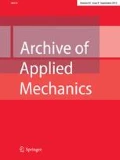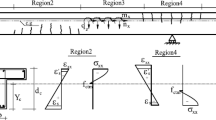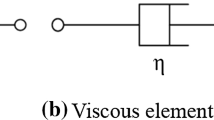Abstract
The evaluation of creep effects in concrete structures is addressed in the literature using different predictive models, supplied by specific codes, and applying the concepts of linear viscoelastic theory with ageing. The expressions used in the literature are mainly based on exponential laws, which are introduced in the integral expression of the Boltzmann principle; this approach leads to the need of finding approximated numerical solutions of the viscoelastic response. In this study, the hereditary fractional viscoelastic model is applied to concrete elements, underlining the convenience of using creep or relaxation functions expressed by power laws. The full reciprocal character of creep and relaxation, described through the power laws, is shown in Laplace domain, and the basic theorems of linear viscoelastic theory are re-written. In order to simplify the solution of fractional expressions, the Grünwald–Letnikov approach is followed and a discretization of fractional operators is applied through a simple matrix procedure. Two cases are examined: The first is the application of the fractional model to the creep laws supplied by international codes, finding the power law which approximates in the best way the creep curve given by the B3 predictive model. The second one is the application to the experimental data of an actual concrete mixture, for which the corresponding power law is found and introduced in the fractional model. A best-fitting procedure is applied to obtain the two parameters of power law in order to describe the hereditary character of concrete creep; afterwards, ageing is interpreted through the variation of coefficients with time. A third application on a concrete beam shows the suitability of the proposed model to the estimation of the delayed deformations of actual concrete structures.









Similar content being viewed by others
References
Chiorino, M.A., Casalegno, C.: Evaluation of the structural response to the time-dependent behaviour of concrete: part I—an internationally harmonized format. Indian Concr. J. 86(12), 25–36 (2012)
Dilger, W.H.: Creep analysis of prestressed concrete structures using creep-transformed section properties. PCI J. 27(1), 98–117 (1982)
Bažant, Z.P.: Inelastic Analysis of Structures. Wiley, Chichester (2002)
Chiorino, M.A.: A rational approach to the analysis of creep structural effects. In: Gardner & Weiss (ed) Shrinkage and Creep of Concrete. ACI SP-227, pp. 107–141 (2005)
Chiorino, M.A., Creazza, G., Mola, F., Napoli, P.: Analysis of aging viscoelastic structures with n-redundant elastic restraints. In: Bažant, Z.P. (ed) Fourth RILEM International Symposium on Creep and Shrinkage of Concrete: Mathematical Modelling, pp. 623–644. Northwestern University, Evanston (1986)
Mola, F., Giussani, F.: Long-term behaviour of cable stayed bridges. Stud. Res. 24, 153–187 (2003). (Fratelli Pesenti, Politecnico di Milano)
Nutting, P.G.: A new general law deformation. J. Frankl. Inst. 191, 678–685 (1921)
Gemant, A.: A method of analyzing experimental results obtained by elasto-viscous bodies. Physics 7, 311–7 (1936)
Scott-Blair, G.W., Gaffyn, J.E.: An application of the theory of quasi-properties to the treatment of anomalous strain–stress relations. Philos. Mag. 40, 80–94 (1949)
Di Paola, M., Pirrotta, A., Valenza, A.: Viscoelastic behavior through fractional calculus: an easier method for best fitting experimental results. Mech. Mater. 43(12), 799–806 (2011)
Podlubny, I.: Fractional Differential Equations. Academic Press, San Diego (1998)
Mainardi, F., Gorenflo, R.: Time fractional derivatives in relaxation processes: a tutorial survey. Fract. Calc. Appl. Anal. 10(3), 269–308 (2007)
Torvik, P.J., Bagley, R.L.: On the appearance of the fractional derivative in the behavior of real materials. J. Appl. Mech. Trans. ASME 51(2), 294–298 (1984)
Celauro, C., Fecarotti, C., Pirrotta, A., Collop, A.C.: Experimental validation of a fractional model for creep/recovery testing of asphalt mixtures. Constr. Build. Mater. 36, 458–466 (2012)
Di Paola, M., Heuer, R., Pirrotta, A.: Fractional visco-elastic Euler–Bernoulli beam. Int. J. Solids Struct. 50, 3505–3510 (2013)
Podlubny, I.: Matrix approach to discrete fractional calculus. Fract. Calc. Appl. Anal. 3(4), 359–386 (2000)
ACI 209.2R08: Guide for Modelling and Calculating Shrinkage and Creep in Hardened Concrete, Report by ACI Committee209, pp. 1–45 (2008)
Dutron, R.: Deformations lentes du beton arme sous l’action des charges permanent. Annales des Travaux Publics de Belgique, Tome 37, 2nd Series (1936)
Granata, M.F., Margiotta, P., Arici, M.: Simplified procedure for evaluating the effects of creep and shrinkage on prestressed concrete girder bridges and the application of European and North American prediction models. J. Bridg. Eng. ASCE 18(12), 1281–1297 (2013). doi:10.1061/(ASCE)BE.1943-5592.0000483
Park, Y.-S., Lee, Y.-H., Lee, Y.: Description of concrete creep under time-varying stress using parallel creep curve. Adv. Mater. Sci. Eng. Article ID 9370514, 1–13. doi:10.1155/2016/9370514 (2016)
Bažant, Z.P., Baweja, S.: Creep and shrinkage prediction model for analysis and design of concrete structures: model B3. In: Al-Manaseer, A. (Ed.) Adam Neville Symposium: Creep and Shrinkage-Structural Design Effects, ACI SP-194, pp. 1–83. Farmington Hills, Michigan (2000)
Di Paola, M., Fiore, V., Pinnola, F.P., Valenza, A.: On the influence of the initial ramp for a correct definition of the parameters of fractional viscoelastic materials. Mech. Mater. 69, 63–70 (2014)
Author information
Authors and Affiliations
Corresponding author
Rights and permissions
About this article
Cite this article
Di Paola, M., Granata, M.F. Fractional model of concrete hereditary viscoelastic behaviour. Arch Appl Mech 87, 335–348 (2017). https://doi.org/10.1007/s00419-016-1196-7
Received:
Accepted:
Published:
Issue Date:
DOI: https://doi.org/10.1007/s00419-016-1196-7




